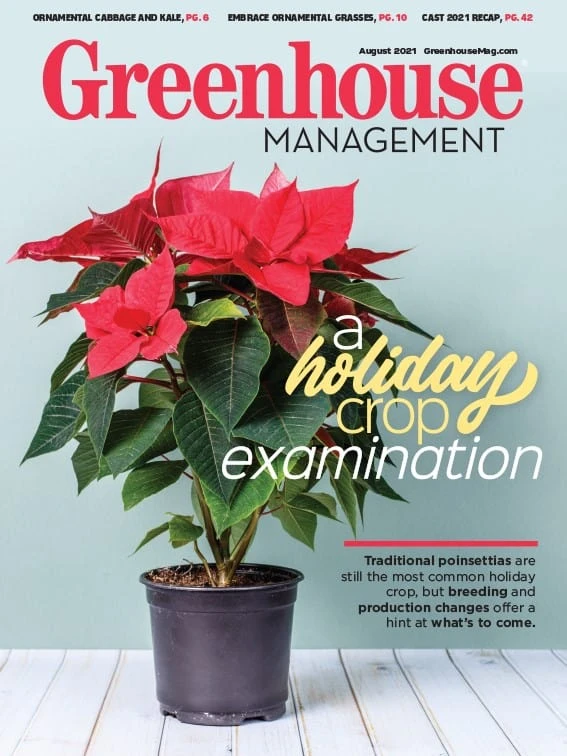
Fall is loved for the red, orange and yellow leaves of hardwood trees, but this is not the only attractive foliage this time of year. Ornamental cabbage and kale have silvery blue-green leaves and colorful heads that add color to our landscapes. This Production Pointers column is going to cover some key tips to producing containerized ornamental cabbage and kale.
There are numerous cultivars of ornamental cabbage and kale available- but which one(s) are right for you? Regardless of what you choose to grow, ornamental cabbage or kale, they are both classified as the same species: Brassica oleracea var. acephala. Practically speaking, the foliage is the differentiating feature between the two. Ornamental cabbage varieties have foliage like “regular” edible cabbage with broad, flat leaves with smooth leaf margins. Alternatively, kale leaves are wavy and have serrated or fringed leaf edges. For both cabbage and kale series, there are a variety of colors available, including purple, red, pink, and white.
Ornamental cabbage and kale are seed-propagated, and plugs can be grown in-house or bought-in. If other plugs are being grown, ornamental cabbage and kale seedlings can be grown alongside other young plants easily. If there aren’t other plugs being grown, purchasing plugs and avoiding plug production mid-summer in the greenhouse can be a major labor-saver. Seedlings are planted into finishing containers filled with a standard 70 to 80% peat moss and 20 to 30% perlite substrate. If seedlings cannot be transplanted into final containers and have to be held for an extended period of time, consider transplanting them into packs for holding.
Both crops are often grown outdoors, making cultural practices including fertilization and growth regulation primary responsibilities. After transplanting into final containers, plants should be provided with 150 to 200 ppm nitrogen from complete, balanced fertilizers such as 20-10-20 and 15-5-15. Plant growth regulators (PGRs) can be used to control unwanted growth and keep plants compact, and several active ingredients are suitable for use on ornamental cabbage and kale. One or two foliar sprays of 5,000 or 2,500 ppm, respectively, are effective in controlling size. For a stronger active ingredient, spraying 2 to 8 ppm uniconazole can also be effective. As with any PGR recommendation, these are suggestions, but concentrations should be tailored for environmental conditions and cultural practices.
The attractive, colorful foliage on ornamental cabbage and kale is why these plants are popular. To achieve the best color, it is important to know what controls foliage coloration in cabbage and kale. Poinsettias are also popular for the colored leaves, or bracts; however, the mechanism for developing foliage coloration is different between the two crops. For poinsettias, short days induce a photoperiodic flowering response which, in turn, causes leaves to turn red. However, it is not the shortening days of fall inducing color change in cabbage and kale leaves; rather, cool air temperatures cause foliage coloration. Three to four weeks of 50 to 55°F nights is usually sufficient to induce foliage coloration. Growing under cool temperature restricts phosphorous uptake, and plants commonly turn purple as anthocyanin accumulates in response to the deficient phosphorous.
Some growers reduce fertilizer in an attempt to enhance foliage coloration, but this practice should be avoided. Reducing overall fertilizer concentrations will reduce phosphorous, which can help promote leaf coloration. However, reducing fertilizer concentrations to provide less phosphorous also reduces concentrations for all the other nutrients too. If deficiency symptoms develop, such as lower-leaf chlorosis from insufficient nitrogen, this can result in less- or non-marketable ornamental cabbage and kale. Maintain adequate fertilization, especially nitrogen, throughout finishing using a low- or no-phosphorous formula such as 13-2-13 or 15-0-15 to provide sufficient macro- and micronutrients while minimizing phosphorous.
The cool fall weather for ornamental cabbage and kale may seem far off, but now is the time to plan for a successful crop. Starting off with the right cultivars, maintaining healthy and attractive plants with fertilization from transplanting through finishing, and toning growth with PGRs will all contribute to great ornamental cabbage and kale crops, and you will just need to wait for those crisp nights to color-up the foliage.

Explore the August 2021 Issue
Check out more from this issue and find your next story to read.
Latest from Greenhouse Management
- Anthura acquires Bromelia assets from Corn. Bak in Netherlands
- Top 10 stories for National Poinsettia Day
- Langendoen Mechanical hosts open house to showcase new greenhouse build
- Conor Foy joins EHR's national sales team
- Pantone announces its 2026 Color of the Year
- Syngenta granted federal registration for Trefinti nematicide/fungicide in ornamental market
- A legacy of influence
- HILA 2025 video highlights: John Gaydos of Proven Winners





